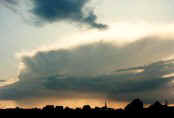| When checking the mass of (raw) weather data available
on the internet, it's easy to get lost. For convenience's sake, one might
look at customer prepared output in numbers or symbols like predicted air temperatures,
weather phenomena,
winds, etc. But this isn't always the best solution in what really
to expect and is in fact the last (control) step of making (your own) forecast. It all
begins with a detailed analysis of forecasted upper air maps starting with the 500 hPa and going down to 700 hPa
& 850 hPa. The conclusions will be fine tuned by checking the maps
of maximum upper winds, mean sea level pressure (MSLP), vertical motion and instability, theta W,
thickness, soundings, mesoscale output, etc.
Below the major steps & their conclusions have been briefly summed up.
Step 1: analysis 500 hPa
- Flow patterns
Check and mark main trough and ridge axes and try to determine the movement.
Check if they are confluent or diffluent. Check the curvature, look
especially for any changes in the future or developments upstream which may
affect the curvature. Mark possible jets and their associated development
zones (C or A).
- Isothermal patterns
Check major zones of CAA and WAA and locations of cold pools. Look if
they coincide with cyclonic curvature which is a first indication of fronts
or troughs.
Step 2: analysis 700 hPa
- Humidity fields
Compare the analysis of 500 hPa with the 700 hPa humidity chart and try to
define the position of active fronts and/or troughs. Try to detect were
apparent frontal zones on the 500 hPa map do not coincide with humidity
fields on 700 hPa which might indicate low level or upper level features.
Extensions in the humidity pattern indicate weakening fronts or wave
formations. Dry zones indicate strong subsidence.
Step 3: analysis 850 hPa
- Vertical structure
-CAA 500 hPa coincide with CAA 850 hPa: pre-running front is well structured
with most likely active precipitation.
-CAA 500 hPa coincide with WAA 850 hPa: heavy instability with serious risk
for heavy showers/thunderstorms, especially in spring or summer.
-WAA 500 hPa coincide with CAA 850 hPa: instability mainly in lower levels
but decreasing by subsidence or prefrontal heating from aloft.
-WAA 500 hPa coincide with WAA 850 hPa: indication of a strengthening
(upper) high with most likely strong subsidence at all levels.
- Front/trough
-CAA 500 hPa coincide CAA 850 hPa: active front.
-CAA 500 hPa: trough.
-CAA 850 hPa: front, in general weakening and only existing in lower levels.
Step 4: analysis additional parameters
- MSLP (Mean Sea Level Pressure)
Detailed info like position of surface high and lows, kinks in the isobars
indicate exact frontal position, etc.
- Mesoscale output
Detailed info with regards to clouds (type, amount), precipitation
(type, amount), wind (direction, speed), temperatures, etc.
- Humidity charts 500, 850, 925 hPa
Indicate if fronts are surface features or not.
- Upper winds 200, 300 hPa
Detailed info on position of jetstream and jetstreaks.
- Vertical motion and instability indices
Identification active fronts or active parts of upper troughs.
- Theta W* or potential equivalent temperatures 850 hPa & thickness
between different levels
Identification different air masses.
* (Theta W = wet bulb potential temperature)
- Soundings
Identification of position of humidity levels + stability of atmosphere
+ inversions, etc.
- Satellite pictures, radar, lightning maps
Verification of exact position of fronts, showers, thunderstorms.
- Surface observations
Verifications of various weather phenomena.
Step 5: finalizing analysis
- All relevant info for the forecast is put on the 500 hPa map. This map is always the starting point for a
forecast in text form.
A selection of some important weather data on the internet have
been collected via this link. On the
forecasted weather maps you can find below an explanation what to do with
these maps and their conclusions. With this info you should be able to
make your own forecast. Be aware: making "good" forecasts is
just a matter of practise. Every situation, how boring it may look, is a
learning school.
|
